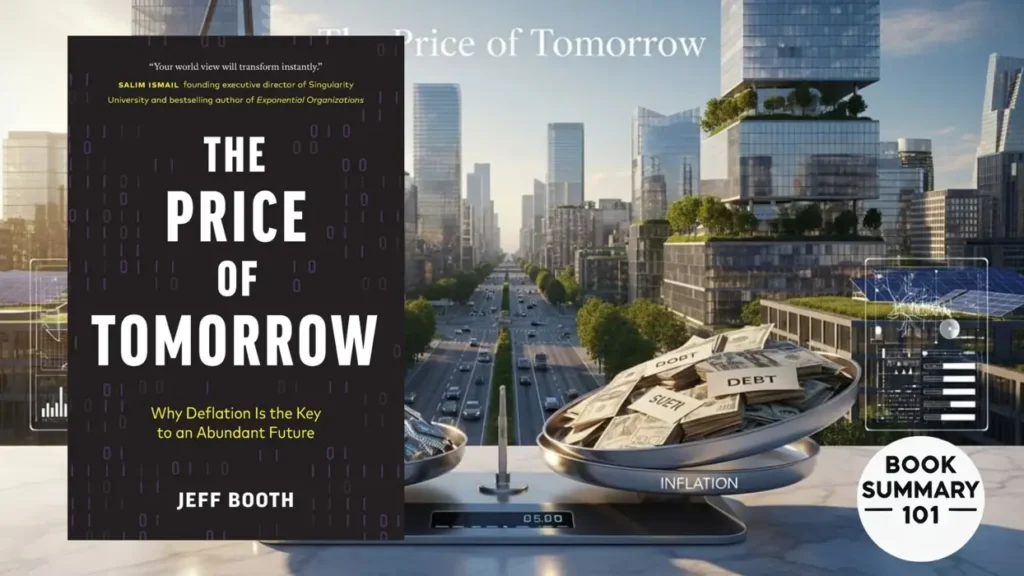Are you ready for a mind-bending take on the economy? Jeff Booth’s book, The Price of Tomorrow: Why Deflation is the Key to an Abundant Future, will make you rethink everything you thought you knew about money, technology, and the future. Booth takes a bold stand, arguing that deflation, often seen as a threat, could actually be the solution to some of our biggest global challenges.
This isn’t your typical finance book; it’s a visionary look at the way tech is reshaping our world—and how we can harness it for good. Let’s dive into the highlights.
Why Read This Book?
Ever feel like the cost of living is getting out of hand? Like no matter how much you work, prices keep creeping up? You’re not alone, and there’s a reason for it. Jeff Booth argues that our current economic system, designed around inflation, is outdated and unsustainable. What if, instead of making everything more expensive, we leaned into the natural deflationary impact of technology to create a more affordable, abundant future? That’s what The Price of Tomorrow is all about. Booth’s perspective challenges us to think differently—and could be just what we need to face the future with hope rather than dread.
What You Need to Know About Deflation and the Future
1. Technology Wants Deflation
Jeff Booth’s central argument in The Price of Tomorrow is that technology naturally leads to deflation—meaning it drives down costs over time, making goods and services more affordable. Think about it: every time a new tech innovation emerges, prices fall as quality improves. For instance, consider smartphones. Twenty years ago, having a powerful computer in your pocket was unthinkable; today, even budget smartphones are incredibly powerful and accessible to billions worldwide. This isn’t just a fluke; it’s a consistent trend across technology.
But here’s the issue: our entire economic system is structured around inflation, which is the gradual increase in prices. Governments and central banks have built policies around creating inflation, assuming that rising prices are a necessary part of a healthy economy. This is why you hear so much about “inflation targets”—central banks actively work to keep inflation at a steady rate. However, Booth argues that technology’s natural tendency to drive down prices is pushing against this goal, creating a fundamental tension in our economy.
This conflict isn’t small—it’s like two giant forces pulling in opposite directions. On one side, we have technology making things cheaper, from groceries to energy to data storage. On the other, governments are printing money and increasing debt to keep inflation alive, hoping to maintain a status quo that no longer aligns with the technological reality. Booth suggests that eventually, something has to give. Either we’ll accept deflation and reshape our policies, or we’ll face serious financial instability.
2. The Trap of Inflation
Inflation isn’t just a policy choice—it’s a deeply ingrained part of the economic system. In a world where inflation is the norm, governments, businesses, and individuals all expect prices to rise over time, which drives certain behaviors. For instance, people are more likely to borrow money because they assume inflation will help them pay off debt with “cheaper” future dollars. Similarly, companies expand and take on debt, expecting that their profits will keep pace with inflation.
Booth explains that this inflation-driven approach is now reaching its limits. To keep inflation going, central banks around the world have been pumping trillions of dollars into the economy, a process often called “quantitative easing.” This influx of money has kept the economy growing on paper, but it’s also created enormous levels of debt. Today, global debt levels are at all-time highs, and paying off this debt requires ever-increasing levels of economic growth.
The problem is that, as Booth argues, perpetual growth isn’t sustainable. It’s increasingly difficult to maintain because technology makes things more efficient, which means fewer resources and less labor are needed over time. Instead of building an economy around endless growth and rising prices, Booth suggests that we should consider a new model—one where deflation is embraced rather than resisted.
Booth believes that by clinging to inflation, we’re essentially “kicking the can down the road,” pushing off hard economic decisions and piling up debt that future generations will struggle to repay. The longer we keep this up, the more painful the eventual adjustment could be. He warns that if we continue to avoid facing the reality of a deflationary tech-driven world, we may see increasing inequality, social unrest, and financial crises.
3. A Deflationary Future Could Be Abundant
Now, here’s where Booth’s vision becomes truly exciting. He argues that a deflationary future doesn’t mean doom and gloom—it could actually be incredibly abundant. Imagine a world where technology makes it possible to meet everyone’s basic needs affordably. In this world, energy could be cleaner and cheaper, food production could be more efficient, and healthcare costs could plummet, making good health accessible to all.
Booth’s vision of a deflationary economy isn’t about restricting consumption; it’s about reimagining prosperity. He believes that embracing deflation would lead to more widespread prosperity because people could afford more with less. If the cost of essentials like healthcare, housing, and education drops thanks to technological advancements, we could have an economy that prioritizes well-being over endless consumption and growth. Instead of feeling constantly pressured to spend more, people could save more, invest in quality of life, and enjoy greater financial stability.
Of course, this kind of shift would require significant changes to our economic policies. Booth argues that if we accept deflation as a positive force, we could build policies that ensure technology’s benefits are widely shared. For instance, we might see increased support for ideas like Universal Basic Income (UBI), which could help people maintain a good standard of living even as technology reduces the demand for traditional jobs. In Booth’s vision, a deflationary future is one where technology liberates us from the pressures of inflation, creating a society built on abundance, rather than scarcity.
Booth’s Vision: Rethinking Economic Policies
Booth doesn’t just identify problems; he offers a roadmap for change. He believes that to embrace deflation, we need to rethink the way we handle economic policy from the ground up. This could include considering Universal Basic Income as a way to support people in an economy where traditional jobs may not be as plentiful due to automation. It could also mean exploring new tax policies that don’t rely solely on growth and consumption but instead foster a stable, resilient society.
One of Booth’s big ideas is that governments should work to allow technology to drive down prices rather than artificially propping them up. In this vision, economic policies would support innovation without assuming that growth alone is the goal. This shift could free us from the cycle of debt and inflation, allowing us to invest more in sustainable practices and long-term planning.
Booth understands that these changes won’t be easy, and they require a major shift in how we think about economics and the purpose of growth. But he argues that the time for change is now. As we continue to face challenges like climate change, inequality, and global instability, he believes that embracing deflation might be the key to creating a more just, abundant world for all.
Real-Life Examples
1. The Rise of Artificial Intelligence and Automation
Booth points to artificial intelligence (AI) and automation as prime examples of technology driving deflation. In industries where AI and automation take root, prices drop, efficiency rises, and the need for human labor changes. Think about how software has already revolutionized areas like data processing, customer service, and even creative industries. As AI advances, Booth argues, it will push prices down further, benefiting society—but only if we’re ready to embrace the changes.
2. Cryptocurrency and Blockchain
Booth touches on how cryptocurrencies, especially Bitcoin, could be part of the solution. Unlike traditional currencies, Bitcoin has a fixed supply, meaning it can’t be inflated by governments or central banks. For Booth, cryptocurrency offers a glimpse of what a deflationary economy might look like: one where value isn’t eroded over time and where savings retain their worth. While he doesn’t see Bitcoin as a cure-all, he believes it represents a step toward a future that resists inflation.
3. Moore’s Law and Technological Cost Curves
To illustrate how rapidly technology drives down costs, Booth reminds us of Moore’s Law: the observation that computing power doubles roughly every two years. As tech becomes more powerful, it also gets cheaper, from computers and cell phones to renewable energy and healthcare innovations. Booth argues that this same principle could apply across the economy if we restructured policies around it.
Join the Conversation!
The Price of Tomorrow doesn’t just talk at you—it invites you to think critically about the future of our economy, society, and technology. This book isn’t just for economists; it’s for anyone who cares about what lies ahead. Booth offers a hopeful perspective that feels both urgent and inspiring, especially as technology continues to evolve at lightning speed. So, what do you think? Could deflation be the key to a brighter, more abundant future? Or is inflation too deeply rooted in our economy to change course?
Let’s discuss: Do you believe deflation could be a positive force in society? What’s your take on Booth’s vision? Let’s dive in and imagine what a world built on abundance might look like!
5 powerful quotes from The Price of Tomorrow by Jeff Booth
📖 “Technology is inherently deflationary.”
Booth reminds us that as technology advances, it always drives down costs while increasing quality.
Simple terms: Tech makes things better and cheaper over time—that’s its nature.
📖 “We are creating an unsustainable future by trying to fight against deflation.”
He warns that governments and central banks printing money to force inflation is like swimming upstream—it won’t last forever.
Simple terms: Fighting deflation with endless money printing will eventually break the system.
📖 “Debt is borrowing from the future to pay for today.”
Booth highlights how our dependence on debt creates a fragile system that mortgages the future for short-term comfort.
Simple terms: We’re living on borrowed time—and borrowed money.
📖 “Abundance, not scarcity, is the natural outcome of technological progress.”
Instead of fearing falling prices, Booth believes we should see them as signs of a better, more abundant world.
Simple terms: Tech can give us more for less—if we let it.
📖 “We must redesign our economic systems to work with technology, not against it.”
Booth calls for bold changes in policy, arguing that clinging to outdated systems will only make the transition harder.
Simple terms: The old rules don’t fit the new world—we need fresh ones.


